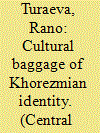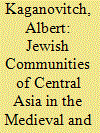|
|
|
Sort Order |
|
|
|
Items / Page
|
|
|
|
|
|
|
| Srl | Item |
| 1 |
ID:
083727


|
|
|
|
|
| Publication |
2008.
|
| Summary/Abstract |
After Uzbekistan gained its independence from Soviet rule, important political and economic changes took place. The mobility of the population has since then increased drastically and created new spaces for the negotiation of social identities as well as new strategies for identity politics among the culturally and regionally diverse population of Uzbekistan. This article aims to contribute to the discussions on social identity and its 'contents' in the light of migration processes. The main argument centres on the importance of what Barth called the 'cultural stuff' of social identities when maintaining boundaries during identification processes. The analysis focuses specifically on certain singing and dancing practices of Khorezmians. It shows how these practices survive, but are also transformed in the context of Tashkent, the capital city of Uzbekistan, where people from different regions reside together and are engaged in performing and presenting their own group identity in reference to 'others'
|
|
|
|
|
|
|
|
|
|
|
|
|
|
|
|
| 2 |
ID:
168992


|
|
|
|
|
| Summary/Abstract |
When the Jews first settled in Central Asia is uncertain, but circumstantial evidence clearly indicates that this happened at least two and a half thousand years ago. In the first millennium AD, the Jews lived only in cities no farther than 750 km east of the Caspian sea (in the eighth–eleventh centuries the sea was called Khazarian). Only later did they migrate to the central part of the region, to cities like Samarkand and Bukhara. It is possible that Jews from Khazaria joined them, since they already had tight trade connections with Central Asia and China. There is no trace of evidence regarding the existence of Jews in the entirety of Central Asia in the early sixteenth century. At the very end of the sixteenth century Bukhara became the new ethnoreligious center of the Jews in that region. In the first half of the nineteenth century, thanks to European travelers visiting Central Asia at that time, the term “Bukharan Jews” was assigned to this sub-ethnic Jewish group. Drawing on a wide range of primary and secondary source materials, this article aims to prove that the presence of Jews in Central Asia was not continuous, and therefore the modern Bukharan Jews are not descendants of the first Jewish settlers there. It also attempts to determine where Central Asia’s first Jewish population disappeared to.
|
|
|
|
|
|
|
|
|
|
|
|
|
|
|
|
| 3 |
ID:
084807


|
|
|
|
|
| Publication |
2008.
|
| Summary/Abstract |
Cold War historiography, in many instances, explained the delimitation of borders in Central Asia as a part of Moscow's divide and rule policy in Turkestan. However, the viability of this approach can be challenged by an examination of the archival documents of the time and the actual publications of the nationalities commissariat under Stalin. Among the Bolsheviks of Turkestan, Uzbeks were leading the drive towards the repartition of Turkestan, along with their Turkmen comrades who were trying to gain land from the former Khivan Khanate, at that time the People's Soviet Republic of Khorezm. The partition of Khorezm between three newly created administrative divisions, Uzbekistan, Turkmenia and Kirgizia, played a key role in the demarcation of borders in 1924. However, from the point of view of communists from the European parts of the former Tsarist Empire, as well as others from the region, delimitation was first a betrayal of internationalism; second it was an immature project both economically and theoretically; and third, it was believed that the liquidation of the traditional Muslim states of Turkestan, namely the Bukharan Emirate and the Khivan Khanate, would have a negative impact on the image of the Soviet revolution in the eyes of reformers in other Muslim countries in the Middle East.
|
|
|
|
|
|
|
|
|
|
|
|
|
|
|
|
|
|
|
|
|